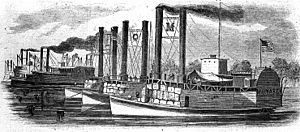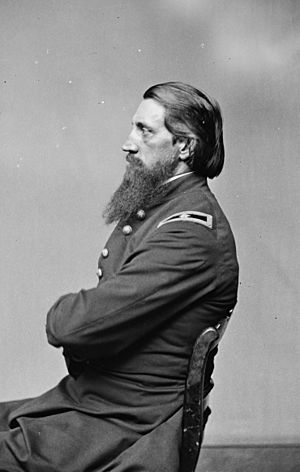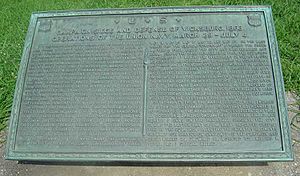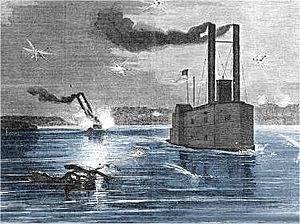Mississippi Marine Brigade facts for kids
Quick facts for kids Mississippi Marine Brigade |
|
|---|---|

The ram ships USS Monarch, USS Queen of the West, USS Lioness and USS Switzerland
|
|
| Active | 1862-1865 |
| Country | United States |
| Branch | Army |
| Role | Amphibious warfare unit |
| Nickname(s) | Ellet Ram Fleet |
| Equipment | Steam powered naval rams |
| Engagements | American Civil War |
| Commanders | |
| Notable commanders |
Alfred W. Ellet |
The Mississippi Marine Brigade was a special unit during the American Civil War. It was part of the Union Army and helped fight battles on land and water. This unit operated from November 1862 to August 1864.
The brigade's main job was to quickly attack Confederate forces. These forces were often found near the Mississippi River and its smaller rivers. Brigadier General Alfred W. Ellet led the brigade. They worked closely with the Union's Mississippi River Squadron. This helped them fight against Confederate ships and land troops.
Even though it was called a "Marine Brigade," it was never part of the United States Marine Corps. It was unique because it reported directly to the Secretary of War, Edwin M. Stanton. This meant it was separate from the regular Army and Navy.
Contents
How the Brigade Was Organized

Brigadier General Alfred W. Ellet was in charge of the United States Ram Fleet. These "ram ships" were special boats that could ram into enemy ships. They had already proven very useful in battles like the First Battle of Memphis.
The ram fleet was not part of the regular Union Navy or Army. It reported straight to the Secretary of War. This caused some problems for Navy leaders. Even though they worked with the Mississippi River Squadron, their command structure was different.
Later, when David Dixon Porter took over the Mississippi River Squadron, he gained control of the ram fleet. Porter needed a force that could fight on both land and water. This force would help stop enemy fire from the riverbanks.
On November 1, 1862, General Ellet was given the task of forming the Mississippi Marine Brigade. This new unit included soldiers for artillery (cannons), cavalry (soldiers on horseback), and infantry (foot soldiers). The ram fleet was used to transport these troops.
The brigade could not recruit soldiers from existing Army or Navy units. Instead, they recruited soldiers who were recovering from injuries in hospitals. Ellet promised these recruits bonuses and good conditions. He also offered them a chance to become famous.
On November 5, Ellet's nephew, Charles R. Ellet, became a colonel. He was only 19 years old, making him one of the youngest colonels in the Union Army. Another nephew, John A. Ellet, also served as a Lieutenant Colonel in the brigade.
The brigade had about 350 officers and men. This included the crews for the nine steam-powered ram ships. Other boats were added to the fleet. These included tugboats like the Alf Cutting and Bell Darlington. There was also a hospital ship called Woodford and transport ships like the Autocrat.
Battles and Campaigns
The Mississippi Marine Brigade took part in many important battles. They were especially active during the Vicksburg Campaign.
Vicksburg Campaign Actions
On December 12, 1862, the Queen of the West was with the USS Cairo on the Yazoo River. The Cairo hit a "torpedo" (an old word for a naval mine) and began to sink. The Queen of the West was able to rescue some of the crew before the Cairo went down.
In February 1863, the Queen of the West sailed past the Confederate defenses at Vicksburg, Mississippi. This helped Admiral David Farragut south of the city. The Queen of the West badly damaged the Confederate ship CSS Vicksburg. It also captured four transport ships that were supplying the Confederates. The ship also destroyed Confederate supplies on the Atchafalaya River. Later, Confederate forces captured the Queen of the West on the Red River. It then became a Confederate ship.
On March 26, the ram ships Switzerland and USS Lancaster also sailed past the Vicksburg defenses. Charles Rivers Ellet commanded the Switzerland. His cousin, John A. Ellet, commanded the Lancaster. Both ships faced heavy fire from the Confederate cannons. The Lancaster ran aground and sank to avoid being captured. The Switzerland was damaged but was repaired. It continued to serve south of Vicksburg.
On June 14, the brigade joined Brigadier General Joseph A. Mower in the Battle of Richmond, Louisiana. They fought with Confederate forces and had three soldiers wounded.
On June 19, General Ellet ordered a special fort to be built. This fort was on the Louisiana side of the Mississippi River, across from Vicksburg. It was built in just four days and protected with thick railroad iron. A large cannon, a 20-pounder Parrott rifle, was placed inside. It fired on Vicksburg starting June 23. The Confederates fired back, but the fort was strong. It fired 98 rounds during the siege. The brigade also placed another cannon, a brass Dahlgren gun, in the fort. These cannons caused a lot of damage to the Confederates.
From June 25-30, a part of the brigade went on an expedition to Greenville, Mississippi.
On June 30, the brigade fought at the Battle of Goodrich's Landing. Two African-American Union regiments were under attack by Confederate forces. The brigade arrived and pushed back the Confederates. They had two soldiers wounded and one killed.
End of the Brigade
In October 1863, the Mississippi Marine Brigade officially became part of the regular Union Army. Before this, it had been separate. The brigade was finally ended in August 1864. Its remaining ships were then used for other duties.
Notable People from the Brigade
- Henry N. Couden - Later became the Chaplain of the United States House of Representatives.
- Brigadier General Alfred W. Ellet - The commander of the Mississippi Marine Brigade.
- Colonel Charles R. Ellet - Led the United States Ram Fleet from November 1862 to August 1863.
- Lieutenant Colonel John A. Ellet - Led the United States Ram Fleet from August 1863 to 1864.



